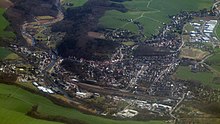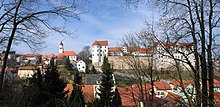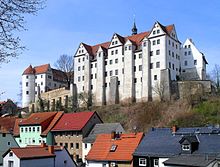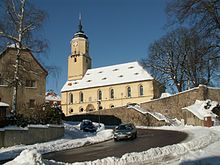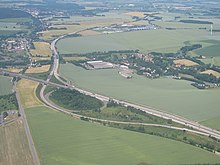Nossen
| coat of arms | Germany map | |
|---|---|---|

|
Coordinates: 51 ° 3 ' N , 13 ° 18' E |
|
| Basic data | ||
| State : | Saxony | |
| County : | Meissen | |
| Height : | 259 m above sea level NHN | |
| Area : | 122.74 km 2 | |
| Residents: | 10,513 (Dec. 31, 2019) | |
| Population density : | 86 inhabitants per km 2 | |
| Postal code : | 01683 | |
| Primaries : | 035242, 035246, 035241 | |
| License plate : | MEI, GRH, RG, RIE | |
| Community key : | 14 6 27 180 | |
| LOCODE : | DE NSN | |
| City structure: | 56 districts | |
City administration address : |
Markt 31 01683 Nossen |
|
| Website : | ||
| Mayor : | Uwe Anke ( independent ) | |
| Location of the city of Nossen in the district of Meißen | ||
Nossen is a small town in the Saxon district of Meißen . It is located on the Freiberger Mulde and the Nossen motorway triangle , which connects the A 14 to the A 4 . Attractions include the on a spur of rock located Nossen Castle and the Altzella .
geography
Geographical location

Nossen is located on the southern edge of the Central Saxon hill country , in the Erzgebirge foothills , in the valley and on the slopes of the Freiberg Mulde. The town hall is 259 meters above sea level. NN high. Dresden is 31 kilometers to the east, Chemnitz 36 kilometers to the southwest and Leipzig 73 kilometers to the northwest. To the southwest lies the Zellwald , one of the largest Saxon forest areas as the remainder of the primeval forest that used to cover the entire Erzgebirge foothills and the Erzgebirge.
Expansion of the urban area
The core city lies in the valley, delimited by the full geomorphological forms (clockwise from the south) Rodigt, Steinbusch, Pfarrberg, Dechantsberg, Kirschberg, Kronberg, Seminarbastei.
Neighboring communities
Neighboring communities are Döbeln , Roßwein , Großschirma , Reinsberg and Striegistal in the district of central Saxony and Käbschützal , Lommatzsch and Klipphausen in the district of Meißen.
| Chub | Lommatzsch | Käbschützal |
| Horse wine |

|
Clip houses |
| Striegistal | Large company | Reinsberg |
City structure
Since January 1, 2014, Nossen has been divided into the following districts after the incorporation of Ketzerbachtal and Leuben-Schleinitz . Since July 1, 2014 the address has been 01683 Nossen. Some street names that occurred repeatedly had to be renamed.
- Evening (K)
- Badersen (L)
- Bodenbach (K)
- Deutschenbora (N)
- Dobschütz (L)
- Elgersdorf (N)
- Eula (Upper and Lower Eula) (N)
- Eulitz (L)
- Gallschütz (K)
- Gohla (N)
- Göltzscha (N)
- Graupzig (L)
- Gruna (K)
- Heynitz (N)
- Höfgen (K)
- Ilkendorf (N)
- Karcha (K)
- Katzenberg (N)
- Klessig (K)
- Kottewitz (N)
- Kreißa (K)
- Leippen (K)
- Leuben (L)
- Lossen (L)
- Solve (K)
- Mahlitzsch (N)
- Mergenthal (N)
- Mertitz (L)
- Mettelwitz (L)
- Mutzschwitz (K)
- Neubodenbach (K)
- Nossen (N)
- Noßlitz (K)
- Oberstößwitz (K)
- Perba (L)
- Pinnewitz (K)
- Praterschütz (L)
- Priesen (K)
- Proda (L)
- Radewitz (N)
- Raßlitz (L)
- Raußlitz (K)
- Rhäsa (K)
- Rüsseina (K)
- Saultitz (K)
- Schänitz (K)
- Schleinitz (L)
- Schrebitz (K)
- Stahna (K)
- Starbach (K)
- Madness (L)
- Wauden (L)
- Wendischbora (N)
- Wolkau (K)
- Wuhsen (N)
- Wish joke (N)
- Zella (N)
- Zetta (K)
- Goat grove (K)
Legend:
- (N): Previous city of Nossen until December 31, 2013
- (K): Until December 31, 2013 municipality of Ketzerbachtal
- (L): Until December 31, 2013, the Leuben-Schleinitz community
history
Nossen was first mentioned indirectly in 1185 as a manor of the knight Petrus de Nozin . He had the land from the Bishop of Meissen as a fief. It is not known whether the Knights of Nozin had their seat on the Rodigt, a Slavic rampart on a hill in Nossen, or whether they already lived in a castle on the Schlossberg.
A church in Nossen is mentioned in 1264. The castle and town passed into the possession of the bishops of Meissen in 1315, and in 1436 into the possession of the Altzella monastery . After the silver finds in Freiberg , mining was also carried out around Nossen (in the valley of the Freiberger Mulde, near the monastery and in the Zellwald). In 1899 mining was stopped.
After the monastery property had been secularized in 1540 , the extensive property continued to be managed by former monastery inmates on behalf of the elector until the founding of the Nossen office in 1555. A few villages from the previous monastery property came to the Freiberg district office . In 1565, the present church was built with the stones of the monastery after a major fire. In 1664 Nossen received city rights .
In the second half of the 19th century, Nossen became a regionally important railway junction : in 1868 the railway lines from Dresden - Meißen - Nossen - Döbeln - Leipzig , 1873 to Freiberg ( Zellwaldbahn / Nossen – Moldau railway ), 1880 to Riesa ( Riesa – Nossen ) and opened in 1899 to Wilsdruff ( Wilsdruffer narrow-gauge railway network ).
From 1871 leather and scales factories were established and in 1896 the Buschow & Beck celluloid doll factory . An economic upswing followed under Mayor Johann Christian Eberle (term of office 1898–1919). He made a special contribution to the enforcement of the current accounts - he was the first chairman of the savings bank association. The new construction of the town hall in 1914/1915 also fell during his term of office.
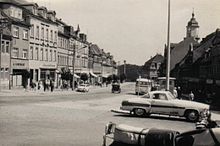
In the years 1944 and 1945 was in Pitzschebachtal before Altzella Klosterpark the satellite camp Nossen / Roßwein the Flossenburg concentration camp , from which 650 concentration camp prisoners in the metal companies Fa. E.Warsitz, Nossen (Nowa Society) and the pressing and blacksmiths E. Broier (Ebro-Werke), Roßwein , had to do forced labor in armaments production. At least 67 of these prisoners died on the death march towards Theresienstadt concentration camp on April 14, 1945.
On May 6, 1945 at around 4 p.m. the city was occupied by the Red Army advancing from Lommatzsch . Shortly before their invasion, the Wehrmacht blew up the railway bridge and the road bridge below the castle (Pöppelmannbrücke) . However, the demolition of the Siebenlehn motorway bridge to the south-east was prevented on May 5, 1945 by Reinhold Ehrlich, the then host of the Huthaus , a restaurant in the valley under the bridge.
Etymology and spelling of the place name
Nossen takes its name from a family of the von Nossen who settled a strip of land with farmers here on behalf of the bishop. The name, probably also the family of the von Nossen family, is of Slavic origin. The word is derived from the Sorbian “Nosno” (nos = nose), which can be translated as “settlement on a protruding rock nose”. The translation "Nasenberg", which is also possible, is suggested if one climbs the Rodigt from a south-easterly direction z. B. viewed from Autobahn 4.
Until the second half of the 19th century there was no uniform German spelling . This can also be seen in the different spellings of the name von Nossen. Despite the different spellings, they were all pronounced almost identically. In the first written tradition from 1185 a Peter of Nozin is mentioned.
The spelling "Nuzzin" (or Ritter von Nuzzin) for the historical Nossen , p. 29 , which is common today , probably goes back to the historical literature of the 19th century. It is questionable whether it can also be found in contemporary sources.
The following historical forms of name are documented:
| 1185: | Petrus de Nozin |
| 1197: | Noscin |
| 1218: | Nozzin |
| 1228: | Nuzin |
| 1373: | Nussin |
| 1403: | Nuts |
| 1432: | Nossin |
| 1529: | Nossaw |
| 1552: | Nossen |
| 1553: | Nossa |
Memorials
- Grave site on the way to the sheep farm in the Heynitz district for a Soviet prisoner of war who was murdered in April 1945
- Memorial stone in the northwest part of the Nossener Friedhof on Freiberger Straße for 87 victims of the subcamp
Incorporations
In May 2012, considerations were announced to merge the neighboring municipality of Reinsberg with Nossen. For this, however, a change of circle would be necessary, which would have required the approval of the Saxon Interior Ministry. After the rejection by the Ministry of the Interior, a merger with the communities of Ketzerbachtal and Leuben-Schleinitz was decided on January 1, 2014.
| Former parish or manor district | date | annotation |
|---|---|---|
| Augustusberg (formerly Keseberg) | November 1, 1935 | |
| Deutschebora | January 1, 1996 | |
| Eula | 1st October 1973 | |
| Heynitz | January 1, 2003 | |
| Ketzerbachtal | 1st of January 2014 | |
| Leuben-Schleinitz | 1st of January 2014 | |
| Zella | November 1, 1935 | |
| Zella (Kammergut) with Kummersheim | December 11, 1948 | Relocation of the Kummersheim district on July 1, 1950 to Marbach (now: OT von Striegistal ) |
On December 1, 1939, parts of Rhäsa (with 3 residents) were reclassified to Nossen.
| Former parish or manor district | date | annotation |
|---|---|---|
| Eve | November 1, 1935 | Incorporation to Rüsseina |
| Badersen | November 1, 1935 | Incorporation to Pröda |
| Bodenbach (with Neubodenbach) | November 1, 1935 | Incorporation to Rhäsa |
| Dobschütz | November 1, 1935 | Incorporation to Pröda |
| Elgersdorf | November 1, 1935 | Incorporation to Deutschenbora |
| Eulitz | November 1, 1935 | Incorporation to Leuben |
| Gallschütz | 1858 | Incorporation to Zetta |
| Göltzscha | November 1, 1935 | Incorporation to Ilkendorf |
| Gohla | November 1, 1935 | Incorporation to Ilkendorf |
| Grabischau (Grabisch Mühle) | May 1, 1839 | Incorporation to Saultitz (as part of the implementation of the rural community order of Saxony in 1838) |
| Greyish | November 1, 1935 | Incorporation to Leuben |
| Gruna | November 1, 1935 | Incorporation to Rhäsa, without Lindigtvorwerk |
| Höfgen | 1st August 1973 | Incorporation after Ziegenhain |
| Ilkendorf | 1st January 1973 | Incorporation to Heynitz |
| Karcha | November 1, 1935 | Incorporation to Raußlitz |
| Katzenberg | November 1, 1935 | Incorporation to Ilkendorf |
| Klessig | November 1, 1935 | Incorporation to Rüsseina |
| Kottewitz | November 1, 1935 | Incorporation to Heynitz |
| Kreißa | November 1, 1935 | Incorporation to Raußlitz |
| Lips | November 1, 1935 | Incorporation after Ziegenhain |
| Leuben | January 1, 1993 | Merger with Schleinitz to Leuben-Schleinitz |
| Lindigt | May 1, 1839 | Incorporation to Leippen (in the course of the implementation of the rural community order of Saxony in 1838) |
| Lindigtvorwerk | November 1, 1935 | Reclassification from Gruna to Ilkendorf |
| Solved | around 1861 | Incorporation to Leippen |
| Lossen | November 1, 1935 | Incorporation after Schleinitz |
| Mahlitzsch | November 1, 1935 | Incorporation to Wendischbora |
| Mergenthal | November 1, 1935 | Incorporation to Deutschenbora |
| Mertitz | November 1, 1935 | Incorporation after Wahnitz |
| Mettelwitz | November 1, 1935 | Incorporation after Wahnitz |
| Mutzschwitz | November 1, 1935 | Incorporation to Höfgen |
| Neugohla | February 1, 1936 | Reclassification of the district from Ilkendorf to Wendischbora |
| Niedereula | November 1, 1935 | Merger with Obereula to form Eula |
| Noßlitz | November 1, 1935 | Incorporation to Rüsseina |
| Obereula | November 1, 1935 | Merger with Niedereula to form Eula |
| Oberstößwitz | November 1, 1935 | Incorporation to Raußlitz |
| Pinnewitz | November 1, 1935 | Incorporation to Raußlitz |
| Praterschütz | November 1, 1935 | Incorporation to Pröda |
| Praising | November 1, 1935 | Incorporation to Rüsseina |
| Proda | July 1, 1950 | Incorporation after Schleinitz |
| Radewitz | November 1, 1935 | Incorporation to Ilkendorf |
| Rasslitz | November 1, 1935 | Incorporation to Leuben |
| Raußlitz | January 1, 1994 | Merger with Rüsseina and Ziegenhain to Ketzerbachtal |
| Rhäsa | March 1, 1994 | Incorporation to Ketzerbachtal |
| Rüsseina | January 1, 1994 | Merger with Raußlitz and Ziegenhain to Ketzerbachtal |
| Saultitz | November 1, 1937 | Renaming to Wolkau |
| Schänitz | around 1861 | Incorporation to Leippen |
| Schleinitz (with Perba) | January 1, 1993 | Merger with Leuben to Leuben-Schleinitz |
| Schrebitz | November 1, 1935 | Incorporation to Raußlitz |
| Stahna | November 1, 1935 | Incorporation to Rüsseina |
| Starbach | March 1, 1974 | Incorporation to Rüsseina |
| Madness | May 1st 1974 | Incorporation to Leuben |
| Trees | November 1, 1935 | Incorporation after Schleinitz |
| Wendishbora (*) | 1st January 1973 | Incorporation to Heynitz |
| Wolkau | November 1, 1935 November 1, 1937 January 1, 1973 |
Incorporation to Saultitz, renaming from Saultitz to Wolkau, incorporation to Rhäsa |
| Wuhsen | November 1, 1935 | Incorporation to Heynitz |
| Wishful joke | November 1, 1935 | Incorporation to Heynitz |
| Zetta | November 1, 1935 | Incorporation to Raußlitz |
| Goat grove | January 1, 1994 | Merger with Raußlitz and Rüsseina to Ketzerbachtal |
(*) Wendischbora was called Altenbora from November 1, 1937 to 1949.
Population development
Development of the population (see also) (from 1998 as of December 31):
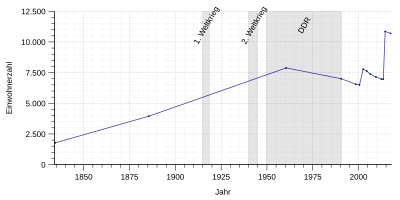
|
|
|---|
(*) From January 1st merger with Ketzerbachtal and Leuben-Schleinitz
politics
City council
In the 2019-2024 electoral period, the city council has 23 seats, as the AfD did not submit enough applicants. The local elections on May 26, 2019 resulted in the following distribution of seats:
| Party / list | Seats |
| Independent citizen list UBL | 9 |
| CDU | 6th |
| AfD | 2 |
| Independent citizen representation UBV | 4th |
| SPD | 1 |
| LEFT | 1 |
mayor
Uwe Anke has been elected mayor since June 11, 2006 (with 95.5% of all valid votes cast and 57% voter turnout), he had previously worked as city treasurer since 1995 and in February 2006 he became administrative administrator for the mayor Hans, who has been in office since June 1990 Haubner was appointed, who went into early retirement. In 2013 he was confirmed in office with 99% of the votes.
coat of arms
Description of the coat of arms : "Three rooted red nut trees in silver." Both the seal and the coat of arms have shown this motif since 1680. At the beginning of the 20th century, however, there were still three real tree images.
Town twinning
Nossen maintains a partnership with the community of Alsheim in Rhineland-Palatinate .
public finances
As a result of the incorporation of the Heynitz community in January 2003, the Nossen debt level rose from 5.735 million euros at the beginning of 2002 to 8.693 million euros at the beginning of 2003. Since then, the city administration has tried to reduce the mountain of debt. On December 31, 2008, the debt was at 4.642 million euros, at the end of 2011 it was only 3.069 million euros (with trade taxation remaining constant).
Culture and sights
Museums
The museum with a permanent exhibition is located in Nossen Castle . a. on the history of the Nossen office. Furthermore, the museum association organizes occasional exhibitions such. B. on the history of the city or the toy exhibition.
The Altzella Monastery Park can be visited in the summer months. There is an exhibition on the history of the Cistercian monastery , which existed from 1162 to 1540 and was the most important in Saxony. The buildings of the monastery (apart from the Konversenhaus and the Romanesque monastery gate) are only preserved as ruins. In the 18th century, the monastery grounds were redesigned in the style of an English landscape garden. In this context, u. a. The mausoleum for the Wettins buried here was laid out on the site of the choir of the former monastery church . The Konversenhaus has been restored at great expense in recent years. On the ground floor is u. a. a lapidarium , the upper floor is used as an exhibition and event room.
The Heimatmuseum Nossen has existed since 1905. It was founded on the initiative of Johann Christian Eberle and until 1990 was mainly housed in Nossen Castle. After the castle passed into state ownership, the museum had to be closed. Since 2011, it has had its own domicile with 14 exhibition rooms not far from the market. A local museum support association ensures that the exhibits are designed, preserved and supplemented.
The Nossen Steam Locomotive Interest Group maintains numerous historic rail vehicles, including series 35 , 50 , 52 and V 100 as well as the mint green painted diesel locomotive 234 304 .
music
The death metal band Purgatory, founded in 1993, comes from Nossen .
Buildings
The Nossener Castle rises above the city , an irregular complex with a predominantly oval courtyard. The castle also houses the local history museum. A tower of the castle, in which there is an old dungeon, is called the Lips-Tullian tower . The town church of Nossen , originally a Renaissance building from 1565, faces the market square. After various fires in 1577, 1618 and 1719, it was heavily modified during the reconstruction. Two portals of the Altzella monastery from the first half of the 13th century have been preserved. The city also has a Catholic chapel.
On the lower market is the replica of the Saxon Post distance column 14 of 1727, at the Forest Straße the partially restored Saxon half-mile column No. 1722 on the postal rate. Dresden -Nossen- Waldheim - Leipzig from the district of Eula and at the former restaurant in the district Altzella the partially restored electoral Saxon whole mile column No. 16 from 1727, whose original location was Marbach-Dreierhäuser on Poststrasse Dresden – Nossen– Chemnitz . Both postal connections led in Nossen over the Muldenbrücke by Matthäus Daniel Pöppelmann .
The Sachsenhof Nossen is home to the largest preserved hall in Art Nouveau decoration in the Meissen district. It was built in 1899, burned down in 1910 and was then rebuilt with a ballroom. In its best times to date, it housed a hotel, a restaurant, the hunter's room and the farmer's room (as meeting rooms) and a cinema. As a result of inheritance disputes, the building was closed in 1997. As a result of a public survey on June 8, 2008, the city of Nossen took over the Sachsenhof as a club and community center as well as an event location in 2009. After construction work started in 2010, the house was reopened in 2012.
The Rodigt Tower , a steel observation tower (built by Herman Fritsche), was left as a no longer accessible monument for many years and has since been demolished. A new tower was built in the same place in 2019 and opened in 2020.
In 2010, in the district of Deutschebora, the physical focus of the Free State of Saxony was marked on Hirschfelder Weg, which was determined in 2009 by the state company Geobasisinformation .
Near the districts of Radewitz and Saultitz is the Radewitzer Höhe with the monumental tomb of the formerly local Hansel family. From here you have a beautiful panoramic view of large parts of the rural area of the city of Nossen and beyond when the weather is clear.
Green spaces and recreation
The former old cemetery has been designed as a city park since the 1970s. Originally, this prestige object was to be inaugurated on the 30th anniversary of the GDR in 1979. However, this goal was not achieved and the design dragged on into the post-reunification period. In the urban area of Nossen there is still the Clara-Zetkin-Park and the "Hoe" below the castle.
Also worth mentioning is the Muldental, which is designated as a landscape protection area ( d 82 ) within the district of Meißen on an area of 991 hectares .
Sports
The SV Lokomotive Nossen is the municipal sports club. The carrier used to be the Nossen depot , at that time an important company in Nossen due to the Nossen railway junction. The soccer department is still active today, especially in the children's and youth sector.
Nossen has had a public bath since 1907, and the swimmers and water polo players from Nossen were also successful in competitions. In the 1990s, the outdoor pool was modernized and the pools rebuilt, but the pool was made smaller. During the flooding of the Freiberg Mulde in August 2002 , the pool was flooded and badly damaged, but then restored. The Muldentalsportplatz was completely modernized, also after the damage caused by the 2002 flood, and restored. a. with floodlights. The restaurant at the bath operates a bowling and skittles facility.
Regular events
The Nossen trade association organizes a Christmas market every year on the third weekend in Advent.
Economy and Infrastructure
traffic
Nossen is conveniently located between the federal motorway 4 and the A 14 as well as on the federal road 101 . The city is the start and end point of federal highway 175 . There are motorway junctions at Siebenlehn on the A 4 and at Deutschebora (Nossen-Ost) and Rhäsa (Nossen-Nord) on the A 14. The nearest airport is Dresden Airport .
Not much is left of the once extensive railway network. Most recently, only regional trains ran every two hours on the Borsdorf – Coswig line , which were also discontinued on December 12, 2015. On August 21, 2004, the section from Nossen to Großbothen , which had been interrupted since the flood in August 2002 , was opened to traffic again. On the Riesa – Nossen route, freight trains only run from Nossen to Rhäsa Werkbf on weekdays. The Zellwaldbahn from Nossen to Freiberg through the Zellwald has been taken over by an infrastructure company and will serve as a tourist railway line with occasional rail traffic. The Freital-Potschappel-Nossen narrow-gauge railway was shut down as early as 1972 .
The Mulderadweg leads through the city.
Established businesses
In 1962 the production of the scale factory (NOWA, a branch of the Oschatzer scale factory OWA) was switched to plug-in units for electrical engineering and metal bellows (" VEB Noremat Nossen ", plant for components of control technology and automation) and in 1970 the doll factory ( Buschow & Beck , trademark Minerva) switched to the production of assembled printed circuit boards and electronic measuring devices (Clamann & Grahnert, later VEB Präcitronic) . These industrial companies were closed after reunification . In Nossen there was also the “Nossen hair and wool yarn spinning mill” ( popularly : “blanket factory”) and an iron foundry.
The Central Office for Plant Varieties of the Ministry of Agriculture of the GDR ("Plant Variety Office") was located in Alt-Zella. There, the approval of plant varieties for the GDR was coordinated. After the fall of the Berlin Wall, the Plant Variety Office was divided into a branch of the Federal Plant Variety Office (Nossen Testing Center) and a branch of the Saxon State Office for Environment, Agriculture and Geology - Department 7, Plant Production with a Test Station (Saxon State Institute for Agriculture Nossen). In 2012 a new building complex with six houses (construction costs 6.5 million euros) was inaugurated.
Mauersberger & Fritsche (Mafrino) as a machine factory and Mühlenbau Gebr. Jehmlich have survived the political change , albeit smaller than in the GDR. The Nossener chamois leather H. A. Müller GmbH, which was badly affected after the flood of the century , is now producing chamois leather for clothing, gloves, orthopedics, musical instrument making and technical purposes again.
Special paper was produced in the Nossen paper mill (CeDo paper products). There used to be two strands there, one for writing paper and one for packaging up to toilet paper. The last paper machine was shut down in 2007. Now only paper is processed there (coffee filter production). Nossen used to have its own brewery in Augustusberg.
At the time, the Nossen depot was especially important for the maintenance of steam locomotives because Nossen was a railway junction. Today several locomotives and railroad cars are still kept and maintained there. From 2004 to 2012, BW Nossen had what is currently the fastest operational steam locomotive in the world, the DR 18.201 from the private operator Dampf plus .
Nossen currently has flourishing commercial areas in the south almost directly on the federal motorway 4 ("Augustusberg") and in the north on the A 14 ("Heynitz Lehden").
education
Until 1992 there was an institute for teacher training "Geschwister Scholl" (IfL) in Nossen, which was founded in 1955 and continued the tradition of the "Royal Nossen Teachers' Seminar" founded in 1856. The latter was moved from Freiberg to Nossen and closed in 1922, in the meantime continued as a high school with high school diploma until 1955.
In Nossen there is a primary school (opened in 1892, "Pestalozzi School" since 1946 , was a primary school, secondary school and polytechnic secondary school during the GDR era, since 1992 only primary school), a secondary school (opened in 1979 as the 2nd polytechnical secondary school 1984 Alfred Haude Oberschule, from 1990 again 2nd Oberschule Nossen, since 1992 as Nossens Middle School, from 1993 Dr. Eberle School ), as well as a grammar school (in 2006 the 150th anniversary of the institution was celebrated as a school, initially the " Königlichen Lehrerseminar ”and then during the time of the GDR it belonged to the IfL as a training school, only after the fall of the Wall in 1992 as a “ Geschwister-Scholl-Gymnasium ” aimed at completing the Abitur).
Personalities
literature
- Cornelius Gurlitt : Nossen. In: Descriptive representation of the older architectural and art monuments of the Kingdom of Saxony. 41. Issue: Administrative Authority Meißen-Land . CC Meinhold, Dresden 1923, p. 360.
- Ernst Gustav Paul Schneider: The history of the school at Nossen . Nossen 1892. (digitized version) .
- Alfred Berger: A foray through the history of Nossen ... Commemorative publication for the home and school festival Whitsun 1936 , Nossen 1936.
- Klaus Bartusch / Peter Voss (eds.): 825 years of Nossen (1185-2010) , Nossen 2010.
- Klaus Bartusch / Peter Voß: Nossen - when the chimneys were still smoking. Photo documents between 1945 and 1989, Verlag für Kulturgeschichte und Kunst Leipzig, 2004, ISBN 3-910143-91-1 .
- Klaus Bartusch / Peter Voß: Nossen - a city in transition. Photo documents on contemporary history from 1990 to 2009, Verlag für Kulturgeschichte und Kunst Leipzig, 2009, ISBN 978-3-910143-87-6 .
- Klaus Bartusch / Peter Voss (eds.): Nossen - a gem in the center of Saxony. The lovable city in words and pictures from 2009 to 2017, printed by Wagner Digitaldruck und Medien GmbH, ISBN 978-3-938390-33-7 .
- Klaus Bartusch / Peter Voss (eds.): Nossen - from below and from the air. Photo documents of the new large city of Nossen, printed by Wagner Digitaldruck und Medien GmbH, ISBN 978-3-938390-34-4
- A record of purchase records from the City Court of Nossen for the period 1718–1834 can be found in the Saxon State Archives, State Archives Leipzig, inventory 20617 City of Nossen (City Court).
Web links
- City of Nossen
- Nossen in the Digital Historical Directory of Saxony
References and comments
- ↑ Population of the Free State of Saxony by municipalities on December 31, 2019 ( help on this ).
- ↑ City map on www.nossen.de
- ↑ Deutsche Post AG informs. In: Official Gazette of the City of Nossen, June 2, 2014, page 12.
- ↑ Our new Nossen. In: Official Gazette of the City of Nossen, issue 1/2014, December 30, 2013, page 4.
- ^ Documents from the Margrave of Meissen p. 352, line 7
- ↑ Rodigt Castle near Saxony's castles
- ↑ cf. also deviating from this in Johannes Hoffmann von Schweidnitz
- ^ Mining Nossen
- ↑ Object of the month November 2011. Elmshorn Industrial Museum , accessed on December 8, 2019 .
- ↑ Nossen subcamp. Flossenbürg Concentration Camp Memorial, accessed on December 8, 2019 .
- ↑ a b c d e f g h Courtyards and residences in the late medieval empire. A dynastic-topographical handbook (= Residences Research, Vol. 15.I) Thorbecke Verlag Ostfildern 2003, ISBN 3-7995-4515-8 , PDF ( Memento from January 6, 2014 in the Internet Archive ).
- ^ Klaus Bartusch: Nossen in old views Volume 1 , ISBN 978-90-288-6624-9 .
- ↑ History - Knight's Castle and Abbey
- ↑ a b c d e f g h i j k l Nossen in the Digital Historical Directory of Saxony
- ^ Alfred Berger: A foray through the history of Nossen. Commemorative publication for the Nossen home festival in 1936.
- ^ A b c Eduard Beyer: The Cistercian monastery and monastery Alt-cell in the diocese of Meißen. Janssen 1855, p. 197 ( digitized in the Google book search)
- ^ Albert Schiffner: Description of Saxony and the Ernestine, Reuss and Schwarzburg lands. Grimm 1845, p. 204 ( digitized in the Google book search).
- ^ Documents from the Margrave of Meissen p. 352, line 7
- ↑ Reinsberg: The community has merger with Nossen examined. In: Free Press . May 23, 2012, accessed June 1, 2012 .
- ↑ a b c d e f g h i j k l m n o p q r s t u v w x y z aa ab ac ad ae af ag ah ai aj ak al am an ao ap aq ar Das Sachsenbuch, municipal Verlag Sachsen KG, Dresden, 1943.
- ↑ a b c d e f g h i j State Statistical Office of the Free State of Saxony: Area changes
- ↑ a b c d e f g Municipalities 1994 and their changes since 01.01.1948 in the new federal states , Metzler-Poeschel publishing house, Stuttgart, 1995, ISBN 3-8246-0321-7 , publisher: Federal Statistical Office
- ↑ a b c lists of the municipalities incorporated since May 1945 and evidence of the breakdown of the independent manor districts and state forest districts, 1952, publisher: Ministry of the Interior of Saxony
- ^ Official register of local authorities for the German Reich based on the 1939 census, 2nd edition. Verlag für Sozialpolitik, Wirtschaft und Statistik GmbH, Berlin, 1941, publisher of the Statistisches Reichsamt
- ^ Gallschütz in the Digital Historical Directory of Saxony
- ↑ Solve in the digital historical place directory of Saxony
- ^ Schänitz in the Digital Historical Directory of Saxony
- ↑ Data source from 1998: State Statistical Office Saxony
- ↑ December 31
- ↑ October 3rd
- ↑ Territorial status January 1, 2003 (with Heynitz)
- ↑ Population of the Free State of Saxony at the end of each month for selected reporting months by municipality. (PDF; 207 KB) State Statistical Office of the Free State of Saxony , accessed on December 8, 2019 .
- ^ Election results of the 2019 municipal council elections. State Statistical Office of the Free State of Saxony , accessed on December 8, 2019 .
- ↑ Election results for the city council seats in 2019
- ^ The mayors of the city of Nossen from 1834 to 2010 ( Memento from September 3, 2011 in the Internet Archive )
- ↑ (Hupp, O: Kaffee Hag albums, 1920s; Bensing et al., 1984) old coat of arms
- ↑ State Statistical Office Saxony, Municipal Statistics Saxony online
- ↑ Official Journal 2013 January ( Memento from February 15, 2017 in the Internet Archive )
- ↑ Schloss Nossen ( Memento from November 26, 2014 in the Internet Archive )
- ↑ Website Förderverein Heimatmuseum Nossen
- ↑ History of the museum, Heimatmuseum Nossen
- ↑ Exhibitions at Nossen Castle. In: schloss-nossen.de. Schlösserland Sachsen , accessed December 8, 2019 .
- ↑ Sachsenhof Nossen
- ↑ Rooms in the new Sachsenhof Nossen ( Memento from February 16, 2013 in the Internet Archive )
- ↑ Bundessortenamt, test center Nossen
- ^ Department 7 Saxon State Office for Environment, Agriculture and Geology
- ^ New building of the Saxon State Research Center for Agriculture Nossen ( Memento from January 7, 2014 in the Internet Archive )
- ↑ Mauersberger & Fritsche (Mafrino)
- ↑ Gebr. Jehmlich GmbH
- ^ Nossener chamois leather HA Müller GmbH
- ↑ Konos GmbH paper mill
- ↑ Holger Starke: From the brewing trade to the brewing industry: The history of the beer brewery in Dresden and Saxony 1800–1914 . Böhlau, 2005, ISBN 3-412-17404-1 , p. 164 .
- ↑ 18 201 is away from Nossen. Central German Railway Forum, April 30, 2012, accessed on June 1, 2012 .
- ^ Institute for Teacher Education Geschwister Scholl (Ed.): 10 years IfL Nossen: 1955–1965 . Nossen 1965.
- ^ History. Pestalozzi Primary School Nossen, accessed December 8, 2019 .
- ^ History of the Dr. Eberle School in Nossen. Dr.-Eberle-Schule Nossen, accessed on December 9, 2019 .
- ^ Geschwister-Scholl-Gymnasium in Nossen
- ^ City of Nossen (city court). In: State Archives Leipzig. Retrieved March 27, 2020 . (Info text under "Introduction")



